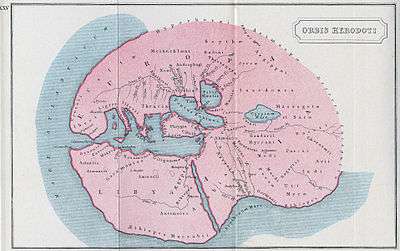Neuri

According to Herodotus the Neuri were a tribe living beyond the Scythian, one of the nations along the course of the river Ὕπανις Hypanis (Southern Bug River), West of the Βορυσθένης Borysthenes (Dniepr river), roughly the area of modern northern (initially north western) Ukraine (historic Volyn) and southern Belarus.
Herodotus's account
According to Herodotus the Neuri (Νευροί) were a tribe living North of the Tyres, and the furthest nation beyond the Scythian farmers along the course of the river Hypanis. The land of the Neuri is described as being bounded by the rivers Ister, Tyras, Hypanis, Borysthenes, Gerras and Tanais; whilst the region itself is referred to as Hypakyris. Herodotus also mentions wild white horses nearby that grazed by a great lake.
In Herodotus's account, he states that the Neuri were driven from their land "one generation before the attack of Darius (512 BC)" by an invasion of serpents. Herodotus says that "they observe Scythian customs" and that "they seem to be magicians." He also reports a Scythian tale that the Neuri changed once a year into wolves, although giving no credence to it. This is perhaps a reference to shamanic practices.
Modern interpretations
Olof von Dalin
The 18th century Swedish historian Olof von Dalin wrote that the Neuri were a mixture of races: Scythians, Greeks and Hebrews who accompanied the Budiner or "Shepherd Scythians", to the Swedish islands around 400 BC. This exodus was the result of pressure from the Macedonians.
- the Neuri seem to be remnants of the Ten Tribes of Israel which Shalmaneser, king of Assyria, brought as captives out of Canaan... [When one realises that] the language of the ancient Finns, Lapps and Estonians is similar to the Hebrew and even that this people in ancient times reckoned their year's beginning from the first of March, and Saturday as their Sabbath, then one sees that the Neuri in all probability had this origin.[1]
Dalin's theory is regarded as quaint by modern scholars of linguistics, who can find no connections between the Semitic languages.
Modern geography
Herodotus description matches modern geography in the following manner:
- Ister = Danube
- Tyras = Dnestr
- Borysthenes = Dniepr
- Gerrοs = Konskaya (a tributary of the Dniepr)
- Tanais = Don
- Hypanis = Southern Bug, flowing into the Black Sea
- Great lake = Polesie Marshes, by the Bialowieza Forest. Wild Tarpans from the Bialowieza Forest seasonally faded to near white in winter.
- Hypakyris = Kalanchak
Geographically, the upper Hypanis merges with the Narew river, which is called Naura in Baltic Lithuanian. The people living on the Naura river were West Balts at that time.[2] There remains a town named Nur, Poland along the upper Bug River, near the Bialowieza Forest. The Nurzec River is in same region.
References
- ↑ (in Swedish) Svea Rikes Historia, 1747, Vol. 1, pp. 54–55
- ↑ Tarasov I. The balts in the Migration Period. P. I. Galindians, pp. 97.
Sources
- Boardman, John; Edwards, I. E. S. (1991). The Cambridge Ancient History. Volume 3. Part 2. Cambridge University Press. ISBN 0521227178. Retrieved March 2, 2015.
External links
![]()